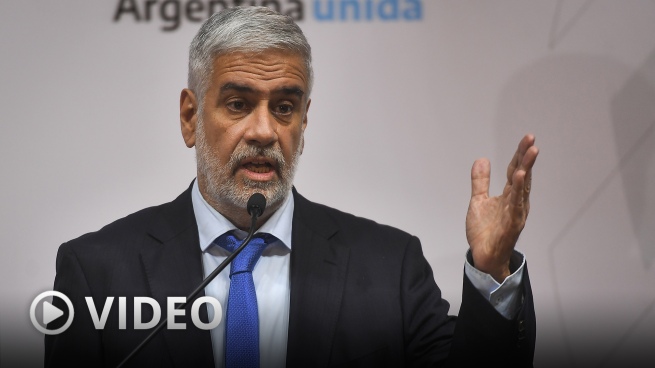Karen Gil- Aleja Cuevas / La Brava
Pamela was raped at age 14 by the stepbrother of her mother’s husband, a few days after her stepfather died of coronavirus and when her mother was in poor health from the same illness. In December 2020, two months after what happened, the mother realized that something was wrong with her daughter, but no matter how much she asked, the teenager did not tell her anything because of the threats made by her aggressor. . Her silence lasted until her pregnancy test came out positive and because of her mother’s beatings.
“It’s for Uncle Fabián,” he told him and recounted what happened.
The 37-year-old mother rebuked the accused, who was a police officer in her community. “We will fix it in a good way”, the 59-year-old man asked him and promised to “make her heal” so that he would not report it.
According to the criminal complaint, Fabián Q. took her to a clandestine clinic that was located in an area between the border of La Paz and El Alto. There the local doctor greeted him with: “Back, Don Fabián?” Recalls her mother, who accompanied them for fear that he would rape her daughter again. Minutes later, Pamela was subjected to curettage, as she had bleeding from taking the pills that she had previously given her assailant.
The days passed and both the pain and the vaginal bleeding did not stop. Fabián was not responsible for the medical care, nor did he comply with the delivery of the groceries that he had agreed with the family in order to make up for his crime. Months later and drunk, at a community party he told that he had raped Pamela. For this reason, in mid-March 2021, the relatives and the original authorities approached her mother and urged her to file a complaint. “We cannot allow a rapist to exist in our community,” said one of the mallkus.
They all accompanied the mother and daughter to the Ombudsman for Children and Adolescents (DNA) in Viacha, where the community is part of, and denounced the incident. The defendant was preventively detained in Chonchocoro for six months and the mother was charged with complicity and placed under house arrest for the same period. The teenager was taken to a temporary shelter of a foundation that welcomes women in a situation of rape.
But before that step and three months after the abortion, she experienced another similar event. At the beginning of March, Andrés (37 years old), an evangelical pastor in the community, made her go to her store, where she went to buy bread, and also sexually assaulted her. Pamela did not say anything due to the fear that her mother would also be accused of it and because – explains the psychologist who treated her at the foundation – she made it natural for any man to take her sexually. She only told him hours after her baby was born, last December. Her fear was so much that she even prevented her thick-set body from showing signs of pregnancy because of the vexation, so the delivery surprised everyone.
Pamela and thousands
Pamela (name changed) is one of the more than 2,329 adolescents under the age of 15 who gave birth in 2021 in Bolivia and one of the 2,078 child and adolescent victims of rape who filed a complaint. She is one of the forced mothers due to sexual abuse, without the possibility of accessing a safe and free abortion, as established by law.
Both in Viacha and throughout the country, sexual abuse against women, mainly girls and adolescents, does not stop and few are punished. According to DNA data from that population, from 2020 to January 2022, 10 rapes of girls and adolescents between the ages of 12 and 16 were reported. Of these cases, four had sentences, one is in oral proceedings and three are in the preparatory stage. Most of the aggressors are relatives up to the fourth degree of consanguinity.
These violations are the ones that reach the instances established by law, since most of them are not reported, says the director of the Special Force to Fight Violence (Felcv) of Viacha, Juan Carlos Quisbert. For example, in the case of Pamela, it is known that two years ago her uncle Fabián raped another of her relatives. That time, he and the mallkus on duty “solved” in the community and the 13-year-old adolescent gave birth to a boy.
Between 2020 and 2021, the Felcv received 10 complaints from adolescents between the ages of 13 and 16 who were harassed. Although there is no data on how many of them became pregnant, the DNA knew of two cases. The first is that of Pamela, who gave birth last December, and the second, of a 13-year-old girl who had a relationship with an older man with the “consent” of the family; however, the regulations consider it to be a violation and the DNA opened the process as such. She is already six months pregnant.
In 2020, 257 pregnancies from 10-year-old girls to 19-year-old adolescents were registered in that municipality, of which 12 were under 15, according to the Ministry of Health. This information was obtained from prenatal controls, but many, like Pamela, do not get to do them.
For these reasons, they do not have the possibility of opting for the legal interruption of pregnancy (ILE), guaranteed in the Penal Code for victims of rape. In Viacha only one was carried out in six years, according to the report Situation of the legal interruption of pregnancy as a human right of women, from the Ombudsman’s Office. The Felcv received 31 complaints between 2015 and 2021.
Photo: La Brava
The person in charge of the Municipal Comprehensive Legal Service (SLIM) and the DNA of Viacha, Gonzalo Vasco, explains that one of the problems for the victims not to opt for an ILE is that the complaints to the DNA arrive when the gestation time is more than six months or even already given birth. This, in his opinion, is due to the fact that families do not report in time for fear of being revictimized and because there is no custom to report, mainly in rural communities, where Pamela is from.

Photo: Rocío Condori
Ignorance is another problem for both the population and the authorities. “There is no obligation for us to give the minor a chance,” says Vasco, but adds that the DNA will be instructed to give the option of assisted abortion.
Rape and pregnancy
Both the United Nations Population Fund and the defense reports infer that the majority of adolescent mothers suffered rape.
The Ombudsman ai, Nadia Cruz, explains that a worrying rate of this crime was registered and in the case of girls and adolescents the figures were increasing.
“I couldn’t argue that it’s because of the pandemic, but that situation of confinement and coexistence with the aggressors has put them in a much more vulnerable situation,” he says.
During 2021, the Public Ministry reported 5,652 cases of sexual violence, of which 2,078 were against children and adolescents and 1,548 rapes (relationship between an older person and a person under 18).
The legal interruptions of pregnancy are not fulfilled despite the norm
In the country there are no official data on how many pregnant women under 15 years of age took advantage of the ILE (legal interruption of pregnancy). The Ombudsman’s Office speaks of 350 legal abortions between 2015 and 2019, but the Ministry of Health gives the data of 332 ILE carried out between 2014 and 2018.
According to the Ombudsman, this latest official data “does not reflect the reality of abortion in Bolivia” and evidences the “deficiency of the norm.” In both cases, they do not break down the ages of the girls, adolescents and women who accessed the ILE.
In contrast, the monitoring of the non-governmental organization IPAS-Bolivia reported 214 ILE in minors between 10 and 15 years old, from 2016 to 2021, which is equivalent to 35 legal abortions per year (or three per month).
Added to this is the data from the National Health Information System (SNIS) of the Ministry of Health, which shows that in 2021 alone, 271 ILE were registered, the majority being due to rape. Although this number is higher than the aforementioned annual average, it is still low compared to the 2,329 pregnancies in children under 15 years of age reported by the Ministry of Health last year. This means that only 11.6% of the 2,329 minors availed themselves of Constitutional Sentence 0206/2014.
In addition, the number of ILE is equally low in relation to the 2,078 violations registered last year.
For the head of Maternal Health of the United Nations Population Fund, Gustavo Tapia, the fact that only 271 minors have accessed the ILE reflects the persistence of harmful practices against adolescents between 10 and 14 years of age. “We are talking about forced pregnancy and child motherhood, because they are still being forced to be mothers or to carry the pregnancy”
Along the same lines, the Ombudsman, Nadia Cruz, expresses her concern, since the number of ILE is not even remotely close to the number of teenage pregnancies and sexual violations.
Another possibility of the low percentage of the ILE is that some of the girls have resorted to clandestine abortions, as happened with Pamela the first time.
From equipment problems to lack of complaints: five causes prevent the ILE
In Bolivia, before 2014, hospitals required a judicial authorization for the legal interruption of pregnancy (ILE), but Constitutional Sentence 0206/2014, in force since January 2014, establishes that women can access a legal and safe abortion in cases in which the pregnancy is the product of rape, incest, statutory rape and when her life is in danger.
In these cases, a complaint or formal accusation is not necessary, it is only necessary to present the complaint of the violation, incest or statutory rape and the consent of the victim. The copy of this complaint is the only requirement that the doctor must request to proceed with the ILE.
But this constitutional sentence is not fully complied with, which is confirmed by the defense report, published in 2020 based on information obtained from 44 health centers in the country.
The defense investigation evidenced the non-compliance with the technical procedure for the ILE, that is to say that the majority of the hospitals visited do not have the infrastructure, equipment, medicines and supplies for a legal abortion, as well as independent rooms for manual vacuum aspiration (MVA). , necessary space when this type of procedure is required for an ILE.
Added to this is the lack of knowledge about the ILE of health providers, who did not receive training from the governing bodies.
And if the health personnel do not know the procedures of this possibility, even less so ordinary people. For example, Pamela’s mother (37 years old), with primary school education, did not know that if she reported the first rape her daughter suffered, she could have an abortion, although she did have a clear idea that the adolescent could not assume that responsibility.
To the lack of conditions in health establishments for the procedure of an ILE and the little or no information about the procedure, is added the conscientious objection to which hospital health professionals appeal, moralism and the lack of criminal complaints .

to the norm that allows the ILE.
Photo: Rocío Condori
Coexistence with the aggressors has put the victims in a situation of much greater vulnerability
Nadia Cruz, defender
53
GIRLS
pregnant by rape,
of 2,168, accessed an ILE
During the past year.
There is no obligation for us, from the DNA of Viacha, to give any possibility to the minor
Gonzalo Vasco, SLIM
*This report of the magazine La Brava was made within the framework of the Journalistic Investigation Fund 2022 “Abortion, secrecy and pandemic” of Catholics for the Right to Decide.


















